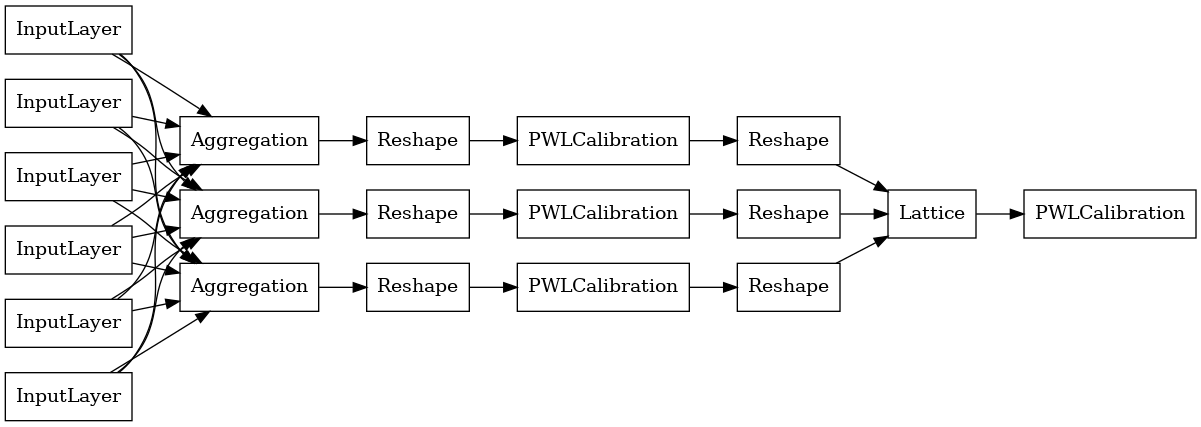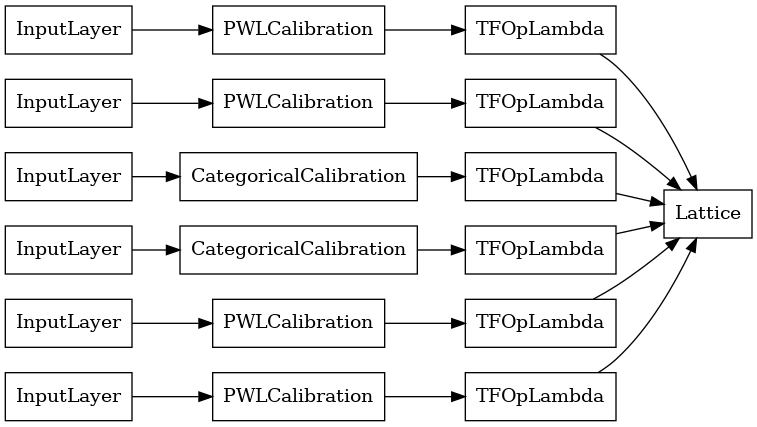 مشاهده در TensorFlow.org مشاهده در TensorFlow.org |  در Google Colab اجرا شود در Google Colab اجرا شود |  مشاهده منبع در GitHub مشاهده منبع در GitHub |  دانلود دفترچه یادداشت دانلود دفترچه یادداشت |
بررسی اجمالی
TFL از پیش ساخته مصالح مدل تابع راه سریع و آسان برای ساخت TFL هستند tf.keras.model موارد برای یادگیری توابع تجمع پیچیده است. این راهنما به تشریح مراحل مورد نیاز برای ساختن یک مدل عملکرد جمعآوری اولیه TFL و آموزش/آزمایش آن میپردازد.
برپایی
نصب پکیج TF Lattice:
pip install -q tensorflow-lattice pydot
واردات بسته های مورد نیاز:
import tensorflow as tf
import collections
import logging
import numpy as np
import pandas as pd
import sys
import tensorflow_lattice as tfl
logging.disable(sys.maxsize)
دانلود مجموعه داده Puzzles:
train_dataframe = pd.read_csv(
'https://raw.githubusercontent.com/wbakst/puzzles_data/master/train.csv')
train_dataframe.head()
test_dataframe = pd.read_csv(
'https://raw.githubusercontent.com/wbakst/puzzles_data/master/test.csv')
test_dataframe.head()
استخراج و تبدیل ویژگی ها و برچسب ها
# Features:
# - star_rating rating out of 5 stars (1-5)
# - word_count number of words in the review
# - is_amazon 1 = reviewed on amazon; 0 = reviewed on artifact website
# - includes_photo if the review includes a photo of the puzzle
# - num_helpful number of people that found this review helpful
# - num_reviews total number of reviews for this puzzle (we construct)
#
# This ordering of feature names will be the exact same order that we construct
# our model to expect.
feature_names = [
'star_rating', 'word_count', 'is_amazon', 'includes_photo', 'num_helpful',
'num_reviews'
]
def extract_features(dataframe, label_name):
# First we extract flattened features.
flattened_features = {
feature_name: dataframe[feature_name].values.astype(float)
for feature_name in feature_names[:-1]
}
# Construct mapping from puzzle name to feature.
star_rating = collections.defaultdict(list)
word_count = collections.defaultdict(list)
is_amazon = collections.defaultdict(list)
includes_photo = collections.defaultdict(list)
num_helpful = collections.defaultdict(list)
labels = {}
# Extract each review.
for i in range(len(dataframe)):
row = dataframe.iloc[i]
puzzle_name = row['puzzle_name']
star_rating[puzzle_name].append(float(row['star_rating']))
word_count[puzzle_name].append(float(row['word_count']))
is_amazon[puzzle_name].append(float(row['is_amazon']))
includes_photo[puzzle_name].append(float(row['includes_photo']))
num_helpful[puzzle_name].append(float(row['num_helpful']))
labels[puzzle_name] = float(row[label_name])
# Organize data into list of list of features.
names = list(star_rating.keys())
star_rating = [star_rating[name] for name in names]
word_count = [word_count[name] for name in names]
is_amazon = [is_amazon[name] for name in names]
includes_photo = [includes_photo[name] for name in names]
num_helpful = [num_helpful[name] for name in names]
num_reviews = [[len(ratings)] * len(ratings) for ratings in star_rating]
labels = [labels[name] for name in names]
# Flatten num_reviews
flattened_features['num_reviews'] = [len(reviews) for reviews in num_reviews]
# Convert data into ragged tensors.
star_rating = tf.ragged.constant(star_rating)
word_count = tf.ragged.constant(word_count)
is_amazon = tf.ragged.constant(is_amazon)
includes_photo = tf.ragged.constant(includes_photo)
num_helpful = tf.ragged.constant(num_helpful)
num_reviews = tf.ragged.constant(num_reviews)
labels = tf.constant(labels)
# Now we can return our extracted data.
return (star_rating, word_count, is_amazon, includes_photo, num_helpful,
num_reviews), labels, flattened_features
train_xs, train_ys, flattened_features = extract_features(train_dataframe, 'Sales12-18MonthsAgo')
test_xs, test_ys, _ = extract_features(test_dataframe, 'SalesLastSixMonths')
# Let's define our label minimum and maximum.
min_label, max_label = float(np.min(train_ys)), float(np.max(train_ys))
min_label, max_label = float(np.min(train_ys)), float(np.max(train_ys))
تنظیم مقادیر پیش فرض مورد استفاده برای آموزش در این راهنما:
LEARNING_RATE = 0.1
BATCH_SIZE = 128
NUM_EPOCHS = 500
MIDDLE_DIM = 3
MIDDLE_LATTICE_SIZE = 2
MIDDLE_KEYPOINTS = 16
OUTPUT_KEYPOINTS = 8
تنظیمات ویژگی
کالیبراسیون ویژگی ها و تنظیمات هر ویژگی با استفاده از مجموعه ای tfl.configs.FeatureConfig . تنظیمات ویژگی ها عبارتند از محدودیت یکنواختی، در هر ویژگی تنظیم (نگاه کنید به tfl.configs.RegularizerConfig )، و اندازه شبکه برای مدل های شبکه.
توجه داشته باشید که ما باید پیکربندی ویژگی را برای هر ویژگی که می خواهیم مدل ما تشخیص دهد، به طور کامل مشخص کنیم. در غیر این صورت مدل هیچ راهی برای اطلاع از وجود چنین ویژگی نخواهد داشت. برای مدلهای تجمیع، این ویژگیها بهطور خودکار در نظر گرفته میشوند و بهدرستی بهعنوان ناهموار در نظر گرفته میشوند.
کوانتیل ها را محاسبه کنید
اگر چه تنظیم پیش فرض برای pwl_calibration_input_keypoints در tfl.configs.FeatureConfig ، مقادیر، برای مدل های از پیش ساخته شده است که ما باید به صورت دستی تعریف keypoints ورودی. برای انجام این کار، ابتدا تابع کمکی خود را برای محاسبه چندک ها تعریف می کنیم.
def compute_quantiles(features,
num_keypoints=10,
clip_min=None,
clip_max=None,
missing_value=None):
# Clip min and max if desired.
if clip_min is not None:
features = np.maximum(features, clip_min)
features = np.append(features, clip_min)
if clip_max is not None:
features = np.minimum(features, clip_max)
features = np.append(features, clip_max)
# Make features unique.
unique_features = np.unique(features)
# Remove missing values if specified.
if missing_value is not None:
unique_features = np.delete(unique_features,
np.where(unique_features == missing_value))
# Compute and return quantiles over unique non-missing feature values.
return np.quantile(
unique_features,
np.linspace(0., 1., num=num_keypoints),
interpolation='nearest').astype(float)
تعریف تنظیمات ویژگی ما
اکنون که میتوانیم چندکهای خود را محاسبه کنیم، برای هر ویژگی که میخواهیم مدل ما به عنوان ورودی بگیرد، یک پیکربندی ویژگی تعریف میکنیم.
# Feature configs are used to specify how each feature is calibrated and used.
feature_configs = [
tfl.configs.FeatureConfig(
name='star_rating',
lattice_size=2,
monotonicity='increasing',
pwl_calibration_num_keypoints=5,
pwl_calibration_input_keypoints=compute_quantiles(
flattened_features['star_rating'], num_keypoints=5),
),
tfl.configs.FeatureConfig(
name='word_count',
lattice_size=2,
monotonicity='increasing',
pwl_calibration_num_keypoints=5,
pwl_calibration_input_keypoints=compute_quantiles(
flattened_features['word_count'], num_keypoints=5),
),
tfl.configs.FeatureConfig(
name='is_amazon',
lattice_size=2,
num_buckets=2,
),
tfl.configs.FeatureConfig(
name='includes_photo',
lattice_size=2,
num_buckets=2,
),
tfl.configs.FeatureConfig(
name='num_helpful',
lattice_size=2,
monotonicity='increasing',
pwl_calibration_num_keypoints=5,
pwl_calibration_input_keypoints=compute_quantiles(
flattened_features['num_helpful'], num_keypoints=5),
# Larger num_helpful indicating more trust in star_rating.
reflects_trust_in=[
tfl.configs.TrustConfig(
feature_name="star_rating", trust_type="trapezoid"),
],
),
tfl.configs.FeatureConfig(
name='num_reviews',
lattice_size=2,
monotonicity='increasing',
pwl_calibration_num_keypoints=5,
pwl_calibration_input_keypoints=compute_quantiles(
flattened_features['num_reviews'], num_keypoints=5),
)
]
مدل تابع کل
برای ساخت مدل از پیش ساخته شده TFL، برای اولین بار یک پیکربندی مدل از ساخت tfl.configs . مدل توابع تجمیعی با استفاده از ساخته شده است tfl.configs.AggregateFunctionConfig . این کالیبراسیون تکهای خطی و طبقهای را اعمال میکند و به دنبال آن یک مدل شبکهای در هر بعد از ورودی پارهشده اعمال میکند. سپس یک لایه تجمعی را بر روی خروجی برای هر بعد اعمال می کند. سپس یک کالیبراسیون خطی تکه ای خروجی اختیاری دنبال می شود.
# Model config defines the model structure for the aggregate function model.
aggregate_function_model_config = tfl.configs.AggregateFunctionConfig(
feature_configs=feature_configs,
middle_dimension=MIDDLE_DIM,
middle_lattice_size=MIDDLE_LATTICE_SIZE,
middle_calibration=True,
middle_calibration_num_keypoints=MIDDLE_KEYPOINTS,
middle_monotonicity='increasing',
output_min=min_label,
output_max=max_label,
output_calibration=True,
output_calibration_num_keypoints=OUTPUT_KEYPOINTS,
output_initialization=np.linspace(
min_label, max_label, num=OUTPUT_KEYPOINTS))
# An AggregateFunction premade model constructed from the given model config.
aggregate_function_model = tfl.premade.AggregateFunction(
aggregate_function_model_config)
# Let's plot our model.
tf.keras.utils.plot_model(
aggregate_function_model, show_layer_names=False, rankdir='LR')

خروجی هر لایه Aggregation میانگین خروجی یک شبکه کالیبره شده بر روی ورودی های پاره پاره است. در اینجا مدل استفاده شده در اولین لایه Aggregation آمده است:
aggregation_layers = [
layer for layer in aggregate_function_model.layers
if isinstance(layer, tfl.layers.Aggregation)
]
tf.keras.utils.plot_model(
aggregation_layers[0].model, show_layer_names=False, rankdir='LR')

در حال حاضر، با هر نوع دیگر tf.keras.Model ، ما کامپایل و برازش مدل به داده های ما.
aggregate_function_model.compile(
loss='mae',
optimizer=tf.keras.optimizers.Adam(LEARNING_RATE))
aggregate_function_model.fit(
train_xs, train_ys, epochs=NUM_EPOCHS, batch_size=BATCH_SIZE, verbose=False)
<tensorflow.python.keras.callbacks.History at 0x7fee7d3033c8>
پس از آموزش مدل خود، می توانیم آن را در مجموعه آزمایشی خود ارزیابی کنیم.
print('Test Set Evaluation...')
print(aggregate_function_model.evaluate(test_xs, test_ys))
Test Set Evaluation... 7/7 [==============================] - 2s 3ms/step - loss: 53.4633 53.4632682800293
